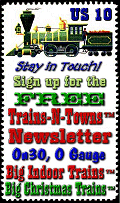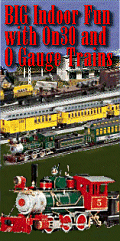|

Note from Editor: In early 2009, Christmas Village project designer Howard Lamey and I began working together to bring the look of the very old tinplate trains and towns into modern-day homes. For this Tribute to Tinplate(tm) project, Howard provided the plans and the "how-to." It's somewhat inspired by the old Lionel "Hellgate" bridge. I thought about asking Howard to call it the "Heaven's Gate" bridge, but he didn't think that was a good idea - maybe because the name "Heaven's Gate" is associated with a certain collossal failure . . . . "Tin City" it is. Of course you can name your bridge whatever you want.
As you'll see in the photos, this bridge is a good size for On30 trains and O gauge tinplate trains as well. If you have O Scale trains, you'll want to check the height of the arches before you glue the whole thing together.
Building the Tin City Bridge
When I started trying to represent iconic structures and accessories of the golden age of toy trains, I couldn't help noticing the bridges, especially the big ones like Lionel's Hellgate bridge. What would it take to make a bridge similar to that one but scaled for my O gauge tinplate trains?
 I cut several bridge patterns out of paper and tried them out with my trains before I decided on a size and shape that I thought would be optimum. The photo to the right shows a cardboard mockup I made to test the dimensions before I started the "real" project. I cut several bridge patterns out of paper and tried them out with my trains before I decided on a size and shape that I thought would be optimum. The photo to the right shows a cardboard mockup I made to test the dimensions before I started the "real" project.
Tools Needed:
- A hole punch capable of punching 1/2" holes. I used a discount tool store 1/2-inch grommet hole punch, the kind you might use to punch holes in a custom tarp or leather strap.
- Hammer
- Utility or craft knife
- Steel straight-edge such as a steel ruler
Materials Needed:
- Thin corrugated cardboard from an express-type shipping/mailing box.
- Clean, solid cardboard, like the kind from the back of a legal pad
- Acid-free white card stock or bond paper for printing the graphic
- Something to trim the top of the towers. I used eight 3/4"-diameter wooden craft store knobs with little dowels to help glue them into place.
- 1"-wide strips of wood to keep the track centered and add lateral strength to the bridge. I cut mine from a yardstick.
- A white glue or glue stick for gluing the graphic to the cardboard
- Primer paint. I used a cheap flat gray spray primer, the kind you can get for about $1 a can at Wal-Mart. This helps seal the surfaces of the bridge before you apply the finish coat. Otherwise, it will take several coats of any glossy or semi-gloss finish coat to get consistent coverage.
- Silver or aluminum spray paint for the finish coat (Paul recommends the cheap aluminum paint from Wal-Mart; it gives a "silver-gray" finish like that used on many of the tinplate railroad accessories of the 1940s and 1950s.)
- Acrylic paint or marker for the edges of the glued-on graphics
- A very fine paint brush for the edges
- A can of glossy clear acrylic finish (indoor-outdoor is best)
Downloading the Plans
Chances are you need the O27/O gauge version shown in the photographs. The PDF versions of the plans are pre-scaled for you. (You'll need Adobe Acrobat Reader on your system to view and print them, but that's a free download from Adobe.) Click on the bold links in the dark boxes to get the plans you need. Print these files on cheap paper, since you'll be transferring the patterns to cardboard anyway.
If you decide that you really need another size altogether, you can access a large .gif file by clicking on the graphics in the boxes above. Copy the .gif files into MS word or a similar program, and resize them to your heart's content.
Downloading the Patterns
I used a realistic stacked stone pattern from Paul's Building Textures Resource page. For this article, Paul has provided two alternate patterns you might like to try. Paul thinks that the stacked stone pattern (left below) is a very good match for Christmas villages and On30 trains (such as the Bachmann/Dept. 56 collector's train shown in some of the photos). The pattern below right might be helpful if you're trying to achieve a tinplate-era look for your bridge.
Paul's Building Textures Resource page has other scales and patterns if you want to investigate other options.
Chances are you need the O27/O gauge version shown in the photographs.
Print these files on acid-free bond paper or light card stock. Print at least one copy for now, to get you started, but you'll need more copies eventually.
Build the Main Body First
Most of the structure is made from fine corrugated cardboard, the kind you get in express mail boxes, etc. The bridge patterns show what direction the "ripples" from the corrugated cardboard should be going when you draw your pattern. Be careful to follow the directions and be precise - this can produce a very strong bridge that weighs very little.
Careful attention to detail during this phase will go a long way toward creating a sturdy, authentic-looking bridge.
Main Body - You will need to make this part first,  and check the measurements of all other pieces against it as you go. It's a lot easier to adjust the other pieces to work with the main body than the other way around. and check the measurements of all other pieces against it as you go. It's a lot easier to adjust the other pieces to work with the main body than the other way around.
Consider making a template or stencil pattern for transferring the pattern to the sides. But before you start transferring the pattern, figure out the width of the rectangle that will connect the two sides (the length will be 18"). It will be easier to draw the rectangle first, then align the template for the sides against that.
 If possible, you should build the main body from a single piece of fine corruated cardboard, as you can see in the drawing the right. The part connecting the two sides should be wide enough to hold the widest track you expect to use with this bridge, plus the two 1"-strips along the edge. Add at least 1/8" to your measurements to be on the "safe side." Pay attention to the direction of the "ripples" as you transfer the pattern, and use a straight-edge to make certain that you are lined up. If possible, you should build the main body from a single piece of fine corruated cardboard, as you can see in the drawing the right. The part connecting the two sides should be wide enough to hold the widest track you expect to use with this bridge, plus the two 1"-strips along the edge. Add at least 1/8" to your measurements to be on the "safe side." Pay attention to the direction of the "ripples" as you transfer the pattern, and use a straight-edge to make certain that you are lined up.
To help protect the  structural integrity of the side pieces, Paul suggests cutting out the vertical slots before you cut out the overall arch shapes. As you can see, I didn't do that. structural integrity of the side pieces, Paul suggests cutting out the vertical slots before you cut out the overall arch shapes. As you can see, I didn't do that.
To achieve the vertical art deco "beam" effect on the sides of the bridge, use the 1/2" hole punch to make the round part of the cut, then connect the 1/2" holes with vertical cuts using the knife and straightedge (not shown).
Get out a piece of track and the 1" strips of wood to double-check the width of the bottom "rectangle." Remember to leave 1/8" extra clearance. When you are sure you have measured correctly, score the outside (bottom) where the fold will be and carefully fold the sides up. After the sides are folded up, get out the track and 1" strips and check again. This time, you can have a reasonably snug fit, as long as the wood strips and track don't put any outward pressure on the sides.
Assemble a Cross-Tie and Check Clearance - Transfer the pattern for one cross tie, being careful to align the pattern against the corrugation "ripples" as shown on the pattern. Score the fold lines, then cut the pattern out. Fold and assemble it as shown in the photo below left. (You can use paperclips to hold it together temporarily.)
Then, using paperclips, check the clearance of the biggest train you plan to use, using the highest-profile track you plan to use.
As examples, the cross-tie plan supplied should work fine for:
- A Marx tinplate train on old-fashioned O gauge three-rail track (shown).
- An American Flyer train on stock AF track
- An On30 train on Bachmann EZ-Track (shown in title photo).
If, however you have a larger train and/or your track sits higher, you may need to adjust the arch in the cross-tie. As an example, a Lionel Polar Express train running on the supplied Lionel FasTrack(r), may need up to an inch more clearance than my trains do. A true O scale train will need even more. It's a lot easier to adjust this before you have everything assembled and painted.
Apply the Trim - Cut strips of 3/16" cardboard and apply to the ends and tops of the sides. This is easier to do before you glue the main piece into its final shape. I cut separate pieces for the flat "peaks" and glued them on after gluing on the pieces over the arches. This provides a more finished look.
Glue One Side of Cross-Ties
Testing the fit again, glue one side of the cross-ties into place. Don't glue the other side just yet -it's easier to paint the bridge before the main part is in its final configuration.
Prime the Interior - As I was building, I actually primed the main part in stages, starting with the interior surfaces, which are easier to paint before the whole thing goes together. Before I primed, I used blue masking tape to cover areas that I would need to apply glue to later - otherwise, I'd be gluing paint to paint, not cardboard to paper or whatever. When you prime, spray several light coats a few minutes apart, rather than trying to coat the whole surface completely at first.
 The photo to the right shows the interior surfaces, with masking tape where the cross-ties will eventually be glued together and where the 1" strips will be glued down. What you can't see are the vertical lines of tape on the outside where the towers will be glued onto the sides. The photo to the right shows the interior surfaces, with masking tape where the cross-ties will eventually be glued together and where the 1" strips will be glued down. What you can't see are the vertical lines of tape on the outside where the towers will be glued onto the sides.
Transfer the Rest of the Patterns
Base - The base should be layered of at least two layers of fine corrugated cardboard. Each layer should be cut out of one piece. After you've transferred the pattern for one end, using a straightedge to make certain you are "lined up," flip the pattern around and transfer the pattern for the other end.
Towers - I made the towers and their caps from thick, solid cardboard, the kind you get from the back of a writing tablet. If you use fine corrugated cardboard for these, align the pattern so that the "ripples" go the direction shown (lengthwise).
You will need to make four of the tall towers and four of the shorter towers.
Piers (optional) - The exact height of your piers may depend on what, if anything you want the bridge to cross. For example, if your bridge is only crossing a "painted on" river, you won't need any piers at all. My piers were made to accommodate the thickness of the foam insulation I used to represent a snow bank in the title photo. But I didn't attach them - this way I can use the bridge on a totally flat surface, too, if required.
Edge Trim - Not shown on the plans are the 3/16-in. wide cardboard bands that cover all of the edges, tops, and ends of the main section. These should be cut from solid cardboard such as posterboard.
Build the Base
 After you've cut out the base pieces and laminated them, wrap them from the top with acid-free bond paper. Make certain that every inch of the surface is glued down so no bubbles form later. This "smooths out" the edges and gives a smooth surface for the primer and subsequent coats of paint. After you've cut out the base pieces and laminated them, wrap them from the top with acid-free bond paper. Make certain that every inch of the surface is glued down so no bubbles form later. This "smooths out" the edges and gives a smooth surface for the primer and subsequent coats of paint.
The photo to the right shows the bottom of the base before I primed it. You can see how I slit and wrapped the corners.
Attach the Base.
Attach the 1" wood strips - Remove the masking tape from the inside bottom and attach the wood strips. If you do this before the cross-ties are completely installed, you can use a staplegun like I did to staple right through the base into the wood strips for extra holding power.
Attach the Cross-Ties
 Remove the remaining masking tape from the inner surfaces. Then glue the cross-ties to the other wall. Clamp or brace them until the glue has dried thorougly, usually overnight.
This photo shows the outside view after the inside has been primed, and the cross-ties and wood strips have been glued into place. Remove the remaining masking tape from the inner surfaces. Then glue the cross-ties to the other wall. Clamp or brace them until the glue has dried thorougly, usually overnight.
This photo shows the outside view after the inside has been primed, and the cross-ties and wood strips have been glued into place.
Paint the Bridge
Once you have the main part of the bridge attached to the base, prime the parts you haven't primed yet, and allow the paint to dry. I would prime the bottom as well as the rest of the bridge.
Then, using your finish coat (I used Aluminum), put two or more light coats of paint on the entire bridge. Do not remove the remaining masking tape until the bridge is thoroughly painted and the paint is thoroughly dry (usually overnight).
Assemble the Towers
Score the fold lines on the towers before you cut them out.
 Each tower is a long, skinny box, covered with graphic paper and topped with a cardboard cap and finial or other trim of your choice. Each tower is a long, skinny box, covered with graphic paper and topped with a cardboard cap and finial or other trim of your choice.
Vertical Tower Pieces - Fold each tower piece, glue it, and let it dry. Rubber bands can be helpful at this stage. To help keep each tower square and give more gluing surface for subsequent pieces, I cut cardboard squares that would just fit inside each end of the towers and glued them in place as well.
 Apply the printed stone (or block) graphics, using a glue stick or thin coat of white glue. . Only do a section at a time. Measure carefully, make crisp folds, apply a thin layer of glue that completely covers the surface (so there are no bubbles), and press in place. Apply the printed stone (or block) graphics, using a glue stick or thin coat of white glue. . Only do a section at a time. Measure carefully, make crisp folds, apply a thin layer of glue that completely covers the surface (so there are no bubbles), and press in place.
The white edges of the paper may show. With an appropriate color felt-tip pen, marker, or acrylic paint and a very tiny brush, carefully coat just the edge of paper and touch up as needed
Caps and Finials - Make each cap piece by layering four layers of thick non-corrugated cardboard, like you get from the back of a writing table. Glue the pieces of each cap together,  let them dry, then trim them smooth all the way around. let them dry, then trim them smooth all the way around.
I made my finials (round top pieces) from 3/4"-diameter wooden craft store knobs, with 3/16"- mounting holes. I glued short dowels into each finial, then drilled a 1/8" hole in the center of each cap to stick them in.
When all of the glue is dry on the finials and caps, paint them the color of your choice.
Assemble the finials on the towers and glue them together. The photo to the right shows two of the towers set up against the bridge side to check the "fit."
When you are satisfied with the fit, remove the remaining masking tape and glue the towers in place.
Assemble the Piers (Optional)
If you want to use the bridge to cross an actual dip in the terrain (like it does in my title photo), figure out how "deep" (tall) the piers need to be and adjust the plan accordingly. Assemble the boxes like you did for the towers, although the stone or block pattern runs lengthwise, as shown in the photos below.
The following photos show the bridge without and with piers.
Conclusion
To finish this project, apply two or more light coats of a clear satin indoor-outdoor acrylic spray. You want to get thorough coverage without any drips. This will help protect the bridge from dust, moisture, fading, and fingerprints or stains.
Also, if you have a project idea that you would like us to consider, please use let us know.
Finally, now that I'm in "retirement," this hobby has become a sort of avocation for me. Several folks have commissioned me to build specific houses for them. So if you'd like me to "bid" on a project for you, or if you have any questions at all, please use the e-mail address on my order page to contact me directly.
If you liked this project, you may also like:
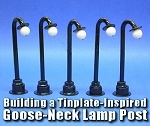 Building Tinplate-Inspired Goose-Neck Lamp Posts Add even more vintage variety to your tinplate-inspired communities, for less than $1 each worth of materials. Free downloadable instructions are provided. Building Tinplate-Inspired Goose-Neck Lamp Posts Add even more vintage variety to your tinplate-inspired communities, for less than $1 each worth of materials. Free downloadable instructions are provided.
- Building a Vintage "Lithographed" Station"
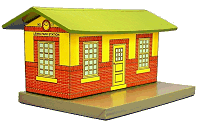 - the first article in our "Tribute to Tinplate" series, based on a prewar American Flyer standard-gauge station. Includes free, downloadable graphics, plans, and instructions for modeling in O/S and Large Scale/Standard Gauge. - the first article in our "Tribute to Tinplate" series, based on a prewar American Flyer standard-gauge station. Includes free, downloadable graphics, plans, and instructions for modeling in O/S and Large Scale/Standard Gauge.
- Building a Vintage Tin-Style Cottage
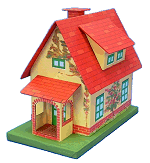 - This project is inspired by a popular pre-war tinplate house that was made to go with standard gauge trains, like the early 1900s-era Ives and Lionel. Paul Race's commercial-quality graphics, as well as Howard Lamey's plans and assembly details are all free, to give your railroad a vintage tinplate look with a few cents' worth of materials. Many options are available, and most graphics and plans can be downloaded directly from the article. - This project is inspired by a popular pre-war tinplate house that was made to go with standard gauge trains, like the early 1900s-era Ives and Lionel. Paul Race's commercial-quality graphics, as well as Howard Lamey's plans and assembly details are all free, to give your railroad a vintage tinplate look with a few cents' worth of materials. Many options are available, and most graphics and plans can be downloaded directly from the article.
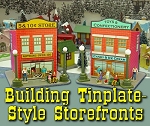 Building TinPlate-Syle Store Fronts -
Expanding our Tribute to Tinplate(tm) community is a set of down-town-style store fronts inspired by a series of tinplate candy containers that were made in the early -to-mid 1900s by West Brothers. The original containers were pretty small, but we've redrawn the graphics in larger scales and added a bit of additional detail so they'll fit into any tinplate or faux-tinplate setting. Building TinPlate-Syle Store Fronts -
Expanding our Tribute to Tinplate(tm) community is a set of down-town-style store fronts inspired by a series of tinplate candy containers that were made in the early -to-mid 1900s by West Brothers. The original containers were pretty small, but we've redrawn the graphics in larger scales and added a bit of additional detail so they'll fit into any tinplate or faux-tinplate setting.
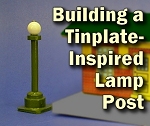 New
Feature - Building a Tinplate-Inspired Lamp Post The ideal accessory for the Lewis Park Station, or any station or city hall on your railroad or holiday village. No, they don't actually light, but they are cheap and easy to build and add a great deal of vintage interest to any setting. Free downloadable plans are available in several scales. New
Feature - Building a Tinplate-Inspired Lamp Post The ideal accessory for the Lewis Park Station, or any station or city hall on your railroad or holiday village. No, they don't actually light, but they are cheap and easy to build and add a great deal of vintage interest to any setting. Free downloadable plans are available in several scales.
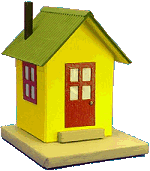 New
Feature - Building a Tinplate-Inspired Watchman's Shanty Back in the day before automated crossings, these were common sites alongside busy rail crossings. Howard's exclusive design pays tribute to a series of tinplate structures that go back a hundred years and include three different scales. His free plans and instructions will help you dress up any indoor railroad or holiday village. New
Feature - Building a Tinplate-Inspired Watchman's Shanty Back in the day before automated crossings, these were common sites alongside busy rail crossings. Howard's exclusive design pays tribute to a series of tinplate structures that go back a hundred years and include three different scales. His free plans and instructions will help you dress up any indoor railroad or holiday village.
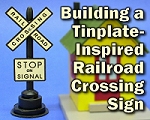 New
Feature - Building a Tinplate-Inspired Railroad Crossing Sign This is the ideal accessory for the Watchman's Shanty project. Based on a series of products that are now available only as expensive collector's items, this easy and almost-free project will add texture, interest, and period to any model railroad or holiday village. New
Feature - Building a Tinplate-Inspired Railroad Crossing Sign This is the ideal accessory for the Watchman's Shanty project. Based on a series of products that are now available only as expensive collector's items, this easy and almost-free project will add texture, interest, and period to any model railroad or holiday village.
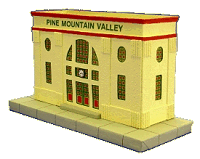 Building the Union Station - This original project by designer Howard Lamey is inspired by two traditions - the cardboard Christmas houses that were popular in US homes between 1928 and 1965 and the Lionel station that was popular for most of the 20th century. Building the Union Station - This original project by designer Howard Lamey is inspired by two traditions - the cardboard Christmas houses that were popular in US homes between 1928 and 1965 and the Lionel station that was popular for most of the 20th century.
- Easy Street Scene - This new
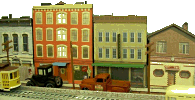 building project uses downloadable building graphics and a little cardboard or foam board to build up a convincing downtown scene that is only a few inches deep - perfect for shelf layouts, tight spots, and dioramas. We also provide links to high-resolution graphics that will work for any scale. building project uses downloadable building graphics and a little cardboard or foam board to build up a convincing downtown scene that is only a few inches deep - perfect for shelf layouts, tight spots, and dioramas. We also provide links to high-resolution graphics that will work for any scale.

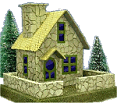 Build a Vintage-Style Cardboard Stone Cottage - This building project is made like the vintage cardboard houses folks used to set around their Christmas tree in the early 1900s (before glitterhouses became common), but its design was inspired by a building that shows up on the "Isle of Sodor." The building uses free downloadable graphic paper to put a realistic stone veneer on an old-world cottage and fence. It works with Christmas villages, or with a little customization, would dress up any indoor railroad. A "brick cottage" option is also shown.
Build a Vintage-Style Cardboard Stone Cottage - This building project is made like the vintage cardboard houses folks used to set around their Christmas tree in the early 1900s (before glitterhouses became common), but its design was inspired by a building that shows up on the "Isle of Sodor." The building uses free downloadable graphic paper to put a realistic stone veneer on an old-world cottage and fence. It works with Christmas villages, or with a little customization, would dress up any indoor railroad. A "brick cottage" option is also shown.
 Log Cabin Building Flat - This "building flat" uses downloadable graphics and foam board or cardboard to dress up a narrow corner of your railroad or village. The techniques in this project can be used for almost any kind of building you want to represent in a tiny space. December, 2007 Log Cabin Building Flat - This "building flat" uses downloadable graphics and foam board or cardboard to dress up a narrow corner of your railroad or village. The techniques in this project can be used for almost any kind of building you want to represent in a tiny space. December, 2007
- Build a Vintage-Style Barn and Silo - This
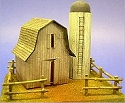 building project uses downloadable graphics to put realistic shingles and siding on an old barn and silo. Like the stone cottage above, it works with Christmas villages, or with a few changes, it would dress up an indoor railroad. building project uses downloadable graphics to put realistic shingles and siding on an old barn and silo. Like the stone cottage above, it works with Christmas villages, or with a few changes, it would dress up an indoor railroad.
Other Articles about cardboard houses include:
|










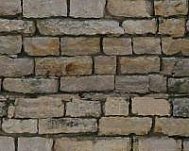
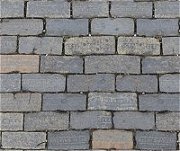
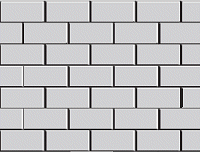
















 Building Tinplate-Inspired Goose-Neck Lamp Posts
Building Tinplate-Inspired Goose-Neck Lamp Posts

 Building TinPlate-Syle Store Fronts
Building TinPlate-Syle Store Fronts New
Feature - Building a Tinplate-Inspired Lamp Post
New
Feature - Building a Tinplate-Inspired Lamp Post New
Feature - Building a Tinplate-Inspired Watchman's Shanty
New
Feature - Building a Tinplate-Inspired Watchman's Shanty New
Feature - Building a Tinplate-Inspired Railroad Crossing Sign
New
Feature - Building a Tinplate-Inspired Railroad Crossing Sign Building the Union Station
Building the Union Station 




